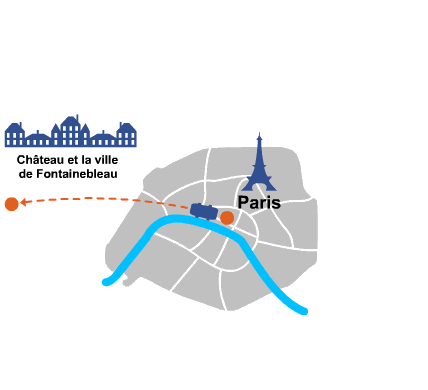Choose your route
Transfer Paris (Hotel or home adress) - Fontainebleau and its Castle

Paris (Hotel or home address) - Fontainebleau and its Castle
Private car and van transfer to/from Paris to Fontainebleau and its Castle
| Passengers | 1 - 2 | 4 - 5 | 6 - 7 | Action |
|---|---|---|---|---|
| Paris - Fontainebleau and its Castle | €130 | €160 | €190 | Book now |
| CDG Airport – Orléans | €290 | €330 | €400 | Book now |
| CDG Airport – Chartres | €220 | €250 | €310 | Book now |
Our private transfer service from Paris to Fontainebleau offers a smooth, elegant ride for travelers seeking cultural exploration or peaceful escape. Whether you depart from a hotel or private home, enjoy the comfort of a professional driver and an air-conditioned vehicle. Once in Fontainebleau, discover the impressive Château de Fontainebleau, a UNESCO World Heritage site, and take time to walk in the tranquil Forêt de Fontainebleau. Our service guarantees punctuality, safety, and comfort, ideal for individuals or families. Rates are transparent and tailored for various group sizes. For more about pricing, check your airport transfer prices online and plan your trip with confidence.
Planning your return or connecting transfer? We also serve key destinations like Orléans and Chartres from CDG Airport. Each ride is operated by licensed professionals offering door-to-door service. Whether you’re arriving at Charles de Gaulle or heading toward the historic cities of the Loire or Eure-et-Loir regions, our transfer ensures a peaceful journey. In Orléans, admire the gothic Sainte-Croix Cathedral and the home of Joan of Arc. In Chartres, the majestic cathedral and charming old town await. Need guidance before you book? Find answers to your common questions in our your airport transfer FAQ. Our commitment is to provide a seamless experience — from booking to arrival.
Book a private minivan transportation from Paris to Fontainebleau
- Fontainebleau’s history : its etymology, kings and reconstruction
- Tourist attractions of Fontainbleau: castles, history, art, jazz festival and biodiversity
- Hotels in Fontainebleau: comfort rooms at low prices, tasty dishes and professional staff
- Visit the Forest of Fontainebleau
- 3 good addresses not to be missed in Fontainebleau
- How to get from Paris to Fontainebleau


















